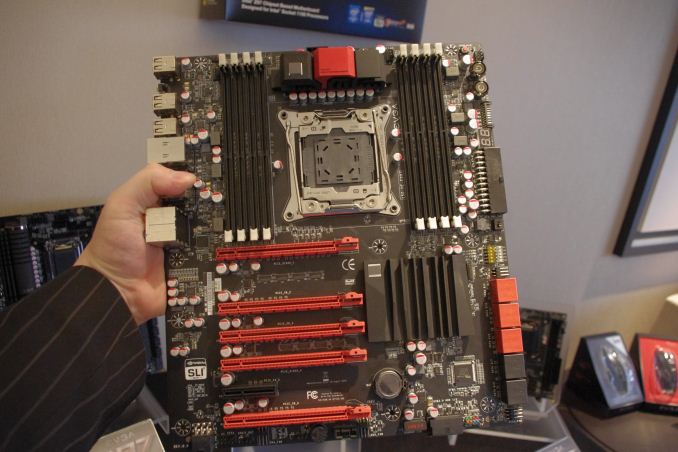Computex 2014: EVGA Shows X99 Prototype
by Ian Cutress on June 12, 2014 6:00 PM EST- Posted in
- Motherboards
- EVGA
- X99
- Computex 2014

A large number of high-end enthusiasts and prosumers are expecting a lot from the next enthusiast level upgrade. While Haswell on the mainstream desktop has been here a year, Haswell-E is still a number of months away. Computex seems to have shown a few X99 chipset models, the chipset designed for Haswell-E, and it looks set to be a significant upgrade in terms of functionality. Most of the major motherboard manufacturers had something on display for X99 – some were out in the open whereas others were behind closed doors and we can’t talk about them. EVGA was happy enough for us to take images of their X99 demo sample, which is almost final in terms of functionality but still needs some work on the aesthetic look.
For X79, EVGA came out with the X79 Dark, the X79 SLI, the X79 FTW and the X79 Classified. This model definitely looks to be in line with the Dark, as that was the only model with a full complement of DRAM slots, but the color styling is more the regular EVGA style.
Due to the size of EVGA, the functionality on their motherboards is not in the same area as an ASUS, GIGABYTE or ASRock, but they do attempt to be versatile, especially with the PCIe layout. There the GPU layout should be suitable for two 3-slot cards, three 3-slot cards or four dual slots cards. Users can adjust the air gap in a dual card setup to fit their needs.
The board does come with dual NIC (Intel I218-V I believe), 10 SATA ports, PCIe switches and extra power to the VGA comes via a 6-pin PCIe connector. EVGA also put their 24-pin ATX power connector at right angles, and is the only company to go down this route for X99 so far. The heatsinks in these images are just for function, but will be replaced with the EVGA branded ones come release. Jacob from EVGA expects the motherboard to be available for X99 launch, which is always a good thing.


















18 Comments
View All Comments
SirKnobsworth - Thursday, June 12, 2014 - link
Any word on the whole DDR4/One DIMM per channel thing? All the specs I can find say that DDR4 only supports one, but most of the X79 motherboards we're seeing seem to have two. Perhaps it's backwards-compatible with DDR3?Kraszmyl - Thursday, June 12, 2014 - link
I also would love an answer to this. Cause all of these x99 boards have eight slots and honestly I wouldn't mind them being ddr3 based and hopefully backwards compatible with sandy/ivy-e.Aidic06 - Thursday, June 12, 2014 - link
No backwards compatibility for sandy/ivy-e, its a 2011 socket, but its a 2011-3 socket and they are not compatible.Kraszmyl - Friday, June 13, 2014 - link
More binging on the hope that like AMD chipsets the x99 is back portable with the previous sockets as well as the current and that's what we are seeing.f0d - Friday, June 13, 2014 - link
i doubt they are backwards compatible as they are a completely different pin count (280 vs 288)i think they changed the spec of ddr3 to allow more than one dimm - some xeon motherboards even had 3 dimms per channel
f0d - Friday, June 13, 2014 - link
whoops so many typos"i think they changed the spec of ddr3 to allow more than one dimm - some xeon motherboards even had 3 dimms per channel"
was supposed to be
"i think they changed the spec of DDR4 to allow more than one dimm - some DDR4 xeon motherboards even had 3 dimms per channel"
dragonsqrrl - Friday, June 13, 2014 - link
I've also heard this, but I just can't wrap my head around it. I'm guessing something was lost in translation through the rumor mill. DDR4 being limited to a single DIMM per channel would be ridiculous and incredibly restrictive, especially in the server/enterprise markets. I think it's more likely that all the X99 boards we've seen thus far is proof that DDR4 is not limited to a single DIMM per channel.Kevin G - Tuesday, June 17, 2014 - link
DDR4 is point-to-point like FB-DIMMs. Going to more than one DIMM per channel requires either registered or load reduced DIMMs from my understanding. Unbuffered memory is limited to 1 DIMM per channel.http://www.ti.com.cn/cn/lit/ml/slyt534/slyt534.pdf
dragonsqrrl - Monday, July 21, 2014 - link
Wow, that sounds pretty ridiculous, at least from a price and performance perspective. If that's the case clearly DDR4 has been catered to server/enterprise environments. From my limited understanding of FB-DIMMs, registers have a negative impact on performance, and increase complexity and thus costs per DIMM. Am I reading this wrong? Why would JEDEC chose to go that route for a memory specification intended for wide adoption in consumer systems, where multi-DIMMs per channel has long since become the norm?BreakArms - Thursday, June 12, 2014 - link
USB 2.0 on a Chipset in 2014. Yawn, Intel.